With the advent of autumn, not all gardeners can rest from work. After all, harvesting and harvesting pickles is not the final stage in preparation for winter. Most bushes and other plants require care in the fall to endure severe frosts. Novice gardeners are interested in how to insulate grapes for the winter, because this bush can not survive the cold period.
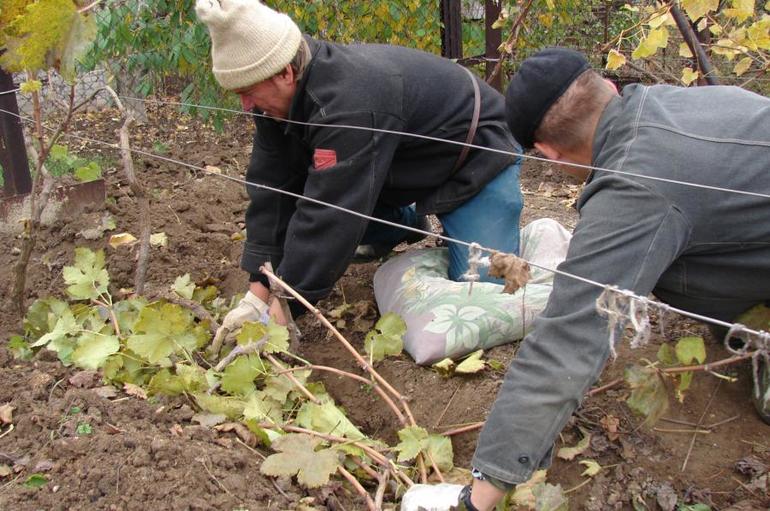
Content
Preparatory stages in the fall
With the right algorithms in the fall, you can successfully save your favorite bushes until spring. It is important to know the main steps:
- watering;
- top dressing;
- pruning
- protection against diseases and pests;
- shelter construction.
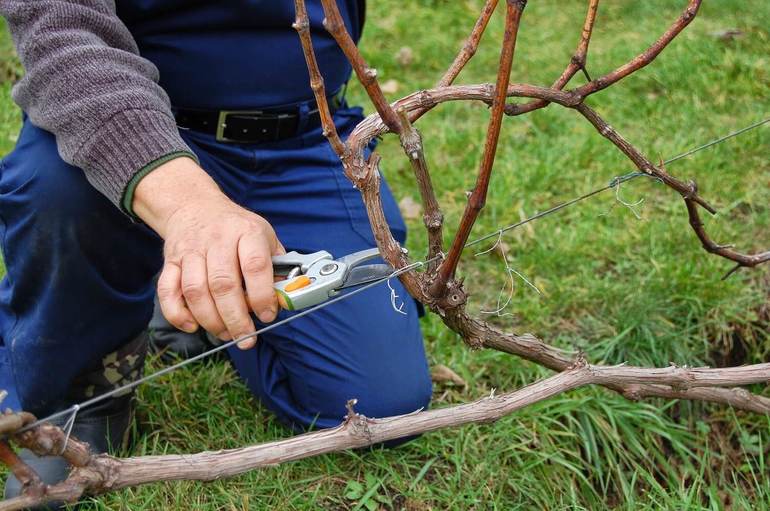
Watering a plant
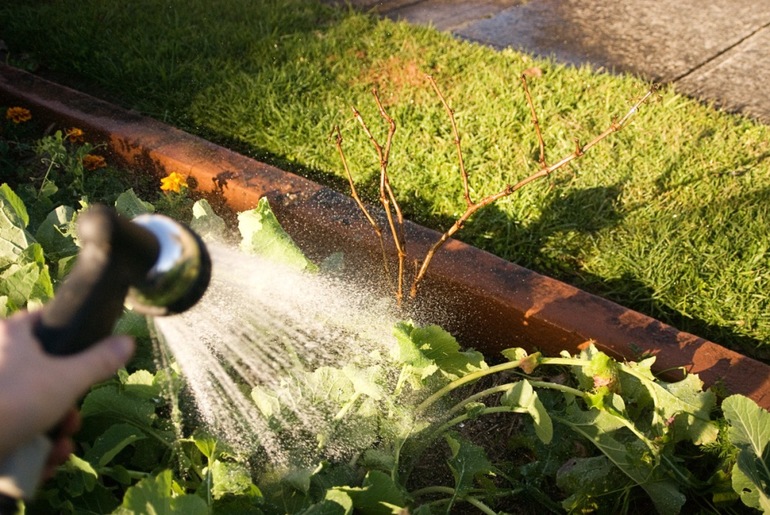
During gardening and harvest ripening grape bushes need water. But do not overfill the plant, excess moisture is fatal for it, as it causes diseases and affects the taste of the fruit.
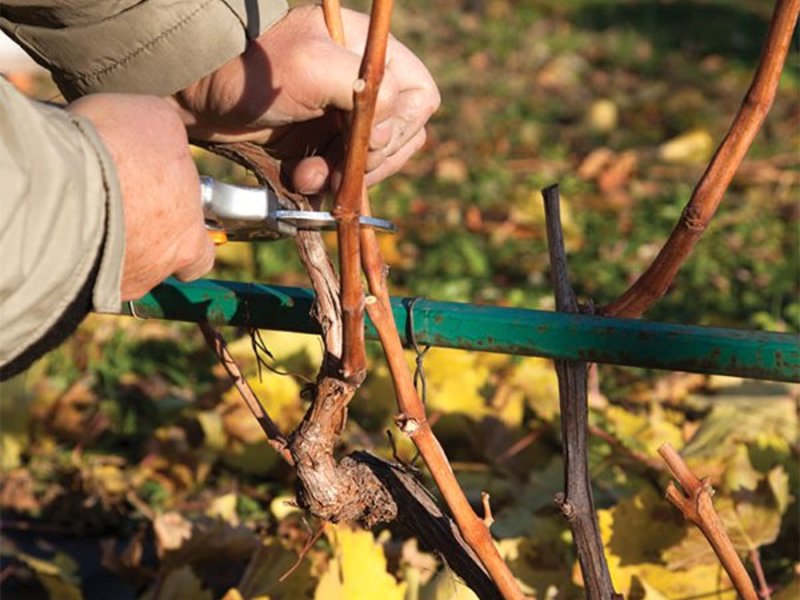 You may be interested in:
You may be interested in:The frequency of watering depends on the type of soil. For example, sand irrigate more often, but with a smaller volume of water. Clay is slightly less common, but until the bush is completely saturated with moisture. Take into account air temperature, the depth of groundwater, the frequency of the wind and its speed, as well as the timing of the onset of frost.
Properly selected time for irrigation ensures increased resistance to wintering of grapes.
Fertilizer for culture
In the autumn season, when the harvest is already harvested, the vine bush weakens. During the full cycle of fruit ripening, he loses a lot of strength and internal reserves. Recovery requires recharge and top dressing. This is done so that the flower buds planted in the vine are preserved, and in the spring the plant pleased with its lush greenery.
Experienced gardeners recommend fertilizing bushes of delicious berries once every 3 years. For this, at 1 m2 25 g of superphosphate and 25 g of potassium top dressing without chlorine are mixed in the vineyard. The resulting dry mass is added to the ground.
For annual replenishment watered with a solution:
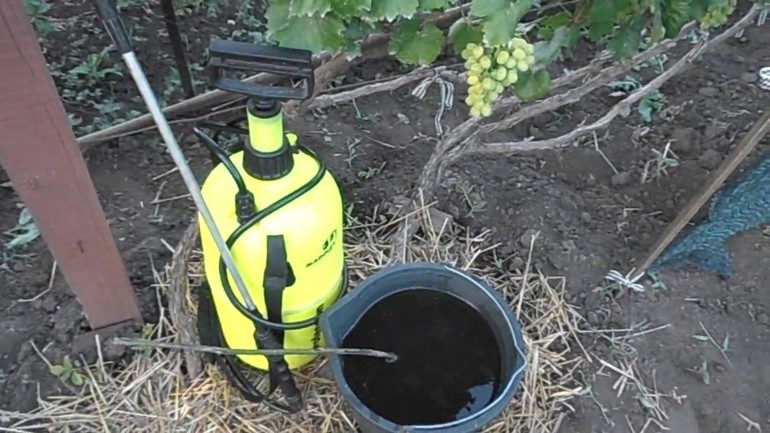
- 10 l of water;
- 20 g of phosphate top dressing;
- 10 g of potash fertilizers.
In order for the plant to have enough nutrients, when watering, the ground should get wet up to 25 cm in depth.
Bush pruning
After all the leaves of the grapes have fallen, they begin to prune. This is done to refresh and rejuvenate the bush, increase the number and taste of fruits, accelerate ripening. In addition, this procedure helps to shelter grapes from frost.
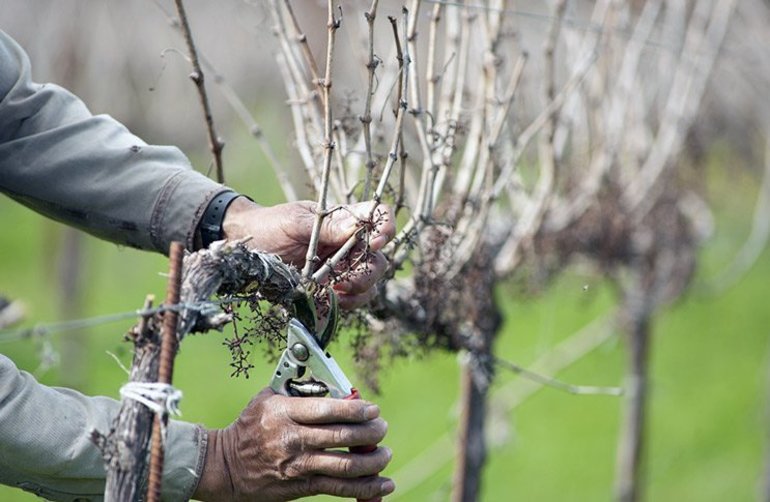
If you start to clean the branches early, you can deprive plants of many plastic substances in the cold season. If you start the action with frost, brittle shoots will crack. The best time to trim is considered mid-September.
Dry and infected sleeves should be removed and burned immediately to rid other plants of diseases. The grape bush is given the desired shape, thinned out from thickets that thicken, interfere with ventilation and deprive the plant of light.
Protection against diseases and pests
The next step after trimming the bush is to treat it from diseases and various pests. If this is not done, the plant will undergo wintering forms of pathogens and will not survive until spring.
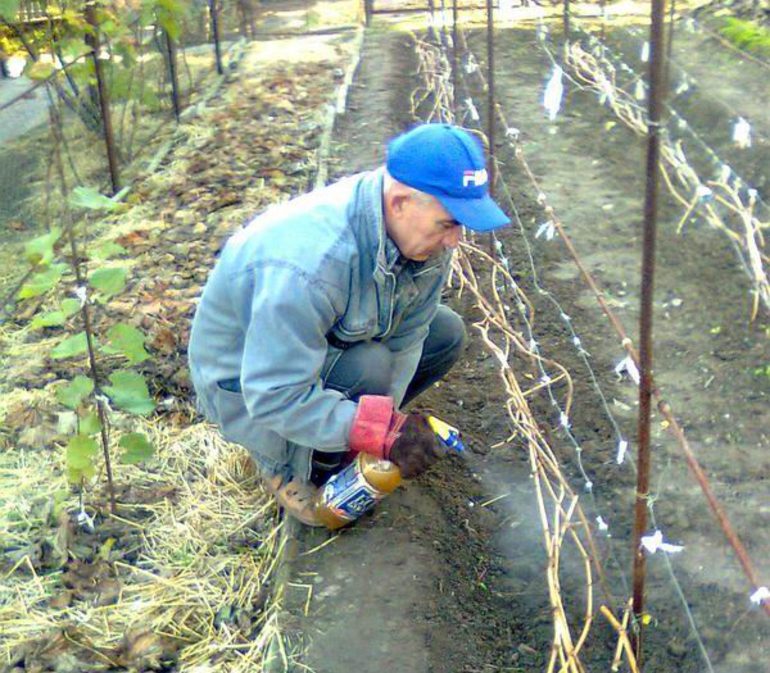
The main tool for keeping the vineyard from diseases is called a solution - 10 tablespoons of salt and 5 tablespoons of soda are added to 10 liters of room temperature water. They process the bush completely, not excluding the leaves. This procedure is carried out at least 3 times in mid-September.
To reduce the number of insects and pathogens will help digging and loosening the earth near the bush. It is recommended to dig a little soil for better disposal of pests.The prepared vine is laid on the ground and sprayed with a solution. To prepare in 5 l of hot water (about 45 degrees) add 200 g of iron or 50 g of copper sulfate.
When the grape bush dries, it is sheltered for the winter season. To prevent it from being attacked by rodents, calcium carbide is used. The pieces are placed in metal cans and placed under a covering material. In addition to helping in the fight against rodents, it also helps in the prevention of diseases.
Insulation for grapes
Grapes are not intended for cold weather, so in autumn it needs to be covered and helped to winter. There are different options focused on a particular area. The main criteria in choosing a material for insulation is:
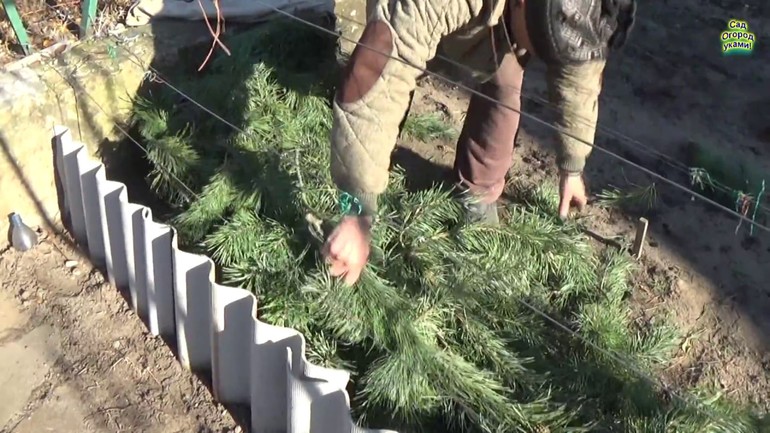
- Grape sort. Some of them withstand low temperatures under easy shelter.
- Growing method.
- Region of growth. In the northern regions there are many coniferous branches, so they will be accessible and easy to use shelters.
Common materials are considered - spruce branches, wood and polyethylene.
Creating a fortification from coniferous branches, it is necessary, after proper preparation of the grapes, to overlay the bushes with them. It lets air through, and its lack provokes the process of decay. In addition, insulation from pine branches delays snow, creating good conditions for wintering.
Wooden shields are used after spraying from pests and diseases. The vine is pressed to the ground and covered with a tree. Between the boards it is recommended to leave slots for free passage of air. The absence of snow is compensated by the material with which seedlings are sheltered in the spring.
Beginning gardeners, unaware of how to properly insulate grapes for the winter, use a plastic film for shelter. But, this is a big mistake. Under such a heater, increased humidity occurs, and the lack of air causes mold and fungal diseases.
The optimal period for the start of insulation is considered to be the end of October - November. It is at this time that there are no warm days, and frosts are not terrible.
Preparing a young vine in winter
Since it is important to warm grapes for the winter in the first year, you should be aware that such bushes do not need to be pruned. It is recommended to remove leaves that fall off and not to feed with nutrients.
In the second year, the grapes are cut, leaving about 4 buds on 1-2 shoots. On the third and fourth - in the fall leave 3-7 buds, recharge is not yet needed. From the age of 4 they begin to fertilize in the autumn season.
In different regions, methods of preserving grapes are different from others. For example:
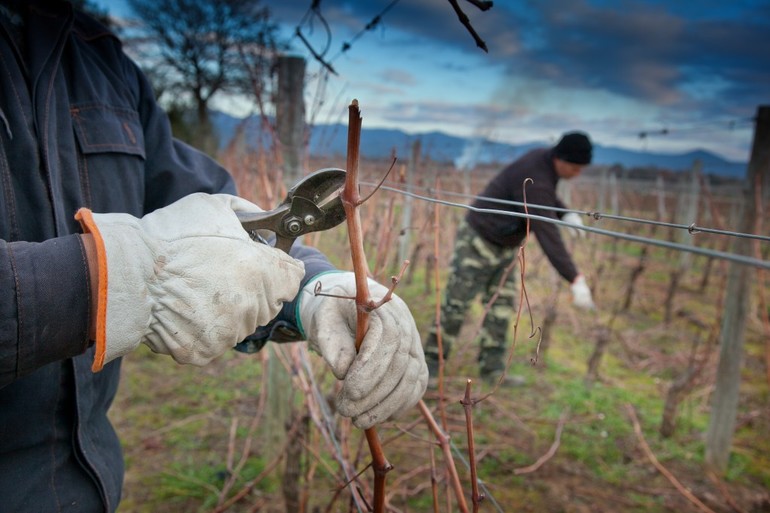
- The middle lane. After removing the leaves, the branches leave a fruit arrow. Unripe shoots are also pruned. They are recognized by the cod that they emit when bent.In addition, you should remove the vines that have already hatched, and dewy roots. Dig the base of the bush 15 cm in depth and remove the root system that protrudes above the ground. The bed around the base is buried with dry sand.
- Moscow region. If the grapes are planted correctly, then it’s easy to cover. The landing pit should be 60 cm by 60 cm in size and 15 cm deep. Choose dry, clear weather and fold the sleeves around, laying them at the bottom of the hole. Having processed the grapes from diseases and pests, they put carbide in a shelter and cover the bush with wooden sheets or roofing material.
- Siberia. Fall It is recommended to feed the grapes. A good covering material is fallen leaves. They are laid about 35 cm thick and insulated from above. The last layer is recommended to lay coniferous branches or tops of vegetables.
- Ukraine. Warming grapes for the winter is not considered a complicated procedure, since the climate there is not significantly different from Russia.
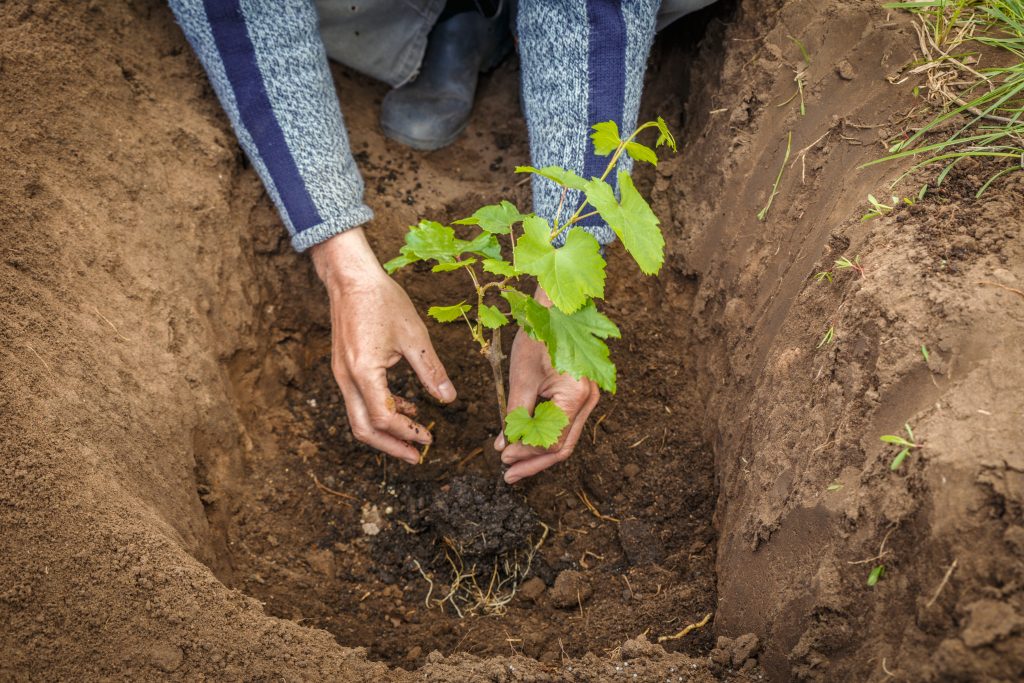 You may be interested in:
You may be interested in:Each region has its own methodology that helps preserve bushes for the winter. The taste of the fruit largely depends on watering, growing techniques and proper storage in the cold season.
Knowing how to properly prepare the grapes for winter, as well as how to preserve and warm it until spring, you can enjoy the juicy fruits for many years.




 Non-covering winter-hardy grape varieties for Moscow region
Non-covering winter-hardy grape varieties for Moscow region How to keep the vine in winter
How to keep the vine in winter When can I transfer grapes to another place in the fall
When can I transfer grapes to another place in the fall How to cover and prepare grapes for the winter in the suburbs
How to cover and prepare grapes for the winter in the suburbs